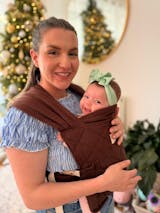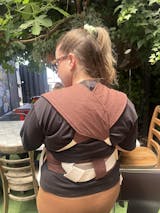OUR CARRIERS HAVE BEEN DESIGNED IN ACCORDANCE WITH IHDI RECOMMENDATIONS
All our carriers have been designed to be "hip-healthy" in accordance with the International Hip Dysplasia Institute (IHDI) recommendations. This means our carriers will support your baby's healthy hip development in those crucial years by ensuring the carrier supports baby's thighs all the way to the knee joint and/or hips are held in the optimal 'M' or 'Froggy' position.
OUR SLINGS COMPLY WITH CPSIA & ASTM SAFETY STANDARDS
We have ensured our sling carriers pass the stringent testing process required to satisfy the Consumer Product Safety Improvement Act (CPSIA) and American Society for Testing & Materials (ASTM) standards in the United States. Unfortunately, unlike the United States, there are no strict safety standards that must be met in order to sell baby carriers in Australia.
T.I.C.K.S GUIDELINES FOR SAFE BABYWEARING
We encourage and promote the T.I.C.K.S guidelines for safe babywearing. These are listed in our all instruction booklets and 'How to Wear' emails that you will receive when purchasing our slings.

FOLLOW OUR SAFETY INSTRUCTIONS FOR A SAFE & SUPPORTIVE CARRY
Please read and follow the below safety instructions before first use. Failure to follow these instructions can result in serious injury or death.
Only use the carrier with children weighing between 8 pounds (3.6kg) and 35 pounds (15.9kg).
Check for any damage to seams, fabric or hardware prior to each use. Do not use if damage or ‘wear and tear’ is visible.
Always check to ensure that all knots, buckles, snaps, straps, and adjustments are secure.
Ensure that baby is safely positioned in the carrieraccording to our instructions for use.
SUFFOCATION HAZARD
Babies younger than 4 months can suffocate in this carrier if face is pressed against your body.
Babies at greatest risk of suffocation include those born prematurely and those with respiratory problems.
Check often to ensure baby’s face is uncovered, clearly visible and away from your body at all times.
Ensure that baby is not curled into a position with baby’s chin resting on or near its chest. This position can interfere with breathing even if their nose and mouth are unobstructed.
If you breastfeed your baby in carrier, always reposition after feeding to ensure baby’s face is not pressed against your body.
Ensure the carrier is not worn too tight as it may restrict baby’s breathing (or your own).
Regularly check on baby and baby’s breathing. Ensure that baby is periodically repositioned.
Never use this carrier with babies smaller than 8 pounds (3.6kg) without seeking the advice of a healthcare professional.
Never leave a baby in a sling carrier that is not being worn.
Follow our video tutorials here to correctly position your baby and ensure good airflow.
Failure to use carrier according to these instructions can result in your baby suffocating, causing serious injury or death.
FALL HAZARD
Leaning, bending over, or tripping can cause baby to fall. Keep one hand on baby while moving.
Take care when carrying baby on uneven surfaces and going through doorways or other obstacles.
Never use carrier when balance or mobility is impaired, such as because of exercise, drowsiness, or medical conditions.
Never use carrier while engaging in activities that may place baby at risk, such as cooking and cleaning which involve a heat source or exposure to chemicals.
Never wear carrier while driving or being a passenger in a motor vehicle.
Ensure baby is not within reach of dangerous objects.
When learning to wear your sling carrier always ensure that you have hold of baby and seek help from a second person if needed.
Follow our video tutorials here to ensure you are wearing your baby safely and securely.
Failure to use carrier according to these instructions can result in your baby falling, causing serious injury or death.
COMFORT
When wearing your baby you should feel comfortable, with your baby’s weight distributed evenly across your body.
If all the weight is localised on one shoulder, review our video tutorials here and ensure the carrier is being worn correctly.
Alternate between shoulders when wearing regularly.
This product may not be suitable for people with existing back problems. If use of the carrier causes back pain, stop use immediately and seek medical advice.
Never place more than one baby in the carrier. Never use/wear more than one carrier at a time.
For more information on how to take care when using your sling, please refer to the Australian Competition & Consumer Commission’s safety alert titled ‘What you need to know about: Baby slings’ published June 2014 (see here).
LM & DB Group Pty Ltd (trading as Mumma Etc.) does not, under any circumstance, assume any responsibility for accident or injury (of any type) as a result of use, or misuse, of its products. Use of Mumma Etc. products by the purchaser (and all subsequent users) is undertaken at the users own risk.





